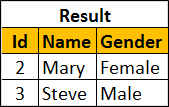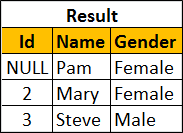Suggested Videos
Part 86 - How to find blocking queries in sql server
Part 87 - SQL Server except operator
Part 88 - Difference between except and not in sql server
In this video we will discuss
1. Intersect operator in sql server
2. Difference between intersect and inner join
Intersect operator retrieves the common records from both the left and the right query of the Intersect operator.
We will use the following 2 tables for this example.
SQL Script to create the tables and populate with test data
The following query retrieves the common records from both the left and the right query of the Intersect operator.
Result :

We can also achieve the same thinkg using INNER join. The following INNER join query would produce the exact same result.
What is the difference between INTERSECT and INNER JOIN
1. INTERSECT filters duplicates and returns only DISTINCT rows that are common between the LEFT and Right Query, where as INNER JOIN does not filter the duplicates.
To understand this difference, insert the following row into TableA
Now execute the following INTERSECT query. Notice that we get only the DISTINCT rows
Result :

Now execute the following INNER JOIN query. Notice that the duplicate rows are not filtered.
Result :

You can make the INNER JOIN behave like INTERSECT operator by using the DISTINCT operator
Result :

2. INNER JOIN treats two NULLS as two different values. So if you are joining two tables based on a nullable column and if both tables have NULLs in that joining column then, INNER JOIN will not include those rows in the result-set, where as INTERSECT treats two NULLs as a same value and it returns all matching rows.
To understand this difference, execute the following 2 insert statements
INTERSECT query
Result :

INNER JOIN query
Result :


Part 86 - How to find blocking queries in sql server
Part 87 - SQL Server except operator
Part 88 - Difference between except and not in sql server
In this video we will discuss
1. Intersect operator in sql server
2. Difference between intersect and inner join
Intersect operator retrieves the common records from both the left and the right query of the Intersect operator.
- Introduced in SQL Server 2005
- The number and the order of the columns must be same in both the queries
- The data types must be same or at least compatible
We will use the following 2 tables for this example.

|

|
SQL Script to create the tables and populate with test data
Create Table TableA
(
Id int,
Name nvarchar(50),
Gender nvarchar(10)
)
Go
Insert into TableA values (1, 'Mark', 'Male')
Insert into TableA values (2, 'Mary', 'Female')
Insert into TableA values (3, 'Steve', 'Male')
Go
Create Table TableB
(
Id int,
Name nvarchar(50),
Gender nvarchar(10)
)
Go
Insert into TableB values (2, 'Mary', 'Female')
Insert into TableB values (3, 'Steve', 'Male')
Go
The following query retrieves the common records from both the left and the right query of the Intersect operator.
Select Id, Name, Gender from TableA
Intersect
Select Id, Name, Gender from TableB
Result :

We can also achieve the same thinkg using INNER join. The following INNER join query would produce the exact same result.
Select TableA.Id, TableA.Name, TableA.Gender
From TableA Inner Join TableB
On TableA.Id = TableB.Id
What is the difference between INTERSECT and INNER JOIN
1. INTERSECT filters duplicates and returns only DISTINCT rows that are common between the LEFT and Right Query, where as INNER JOIN does not filter the duplicates.
To understand this difference, insert the following row into TableA
Insert into TableA values (2, 'Mary', 'Female')
Now execute the following INTERSECT query. Notice that we get only the DISTINCT rows
Select Id, Name, Gender from TableA
Intersect
Select Id, Name, Gender from TableB
Result :

Now execute the following INNER JOIN query. Notice that the duplicate rows are not filtered.
Select TableA.Id, TableA.Name, TableA.Gender
From TableA Inner Join TableB
On TableA.Id = TableB.Id
Result :

You can make the INNER JOIN behave like INTERSECT operator by using the DISTINCT operator
Select DISTINCT TableA.Id, TableA.Name, TableA.Gender
From TableA Inner Join TableB
On TableA.Id = TableB.Id
Result :

2. INNER JOIN treats two NULLS as two different values. So if you are joining two tables based on a nullable column and if both tables have NULLs in that joining column then, INNER JOIN will not include those rows in the result-set, where as INTERSECT treats two NULLs as a same value and it returns all matching rows.
To understand this difference, execute the following 2 insert statements
Insert into TableA values(NULL, 'Pam', 'Female')
Insert into TableB values(NULL, 'Pam', 'Female')
INTERSECT query
Select Id, Name, Gender from TableA
Intersect
Select Id, Name, Gender from TableB
Result :

INNER JOIN query
Select TableA.Id, TableA.Name, TableA.Gender
From TableA Inner Join TableB
On TableA.Id = TableB.Id
Result :


I think it will only return two rows in the case of inner join queries.
ReplyDeleteNo because, inner join doesn't remove duplicate. So it will return 3 rows
ReplyDelete